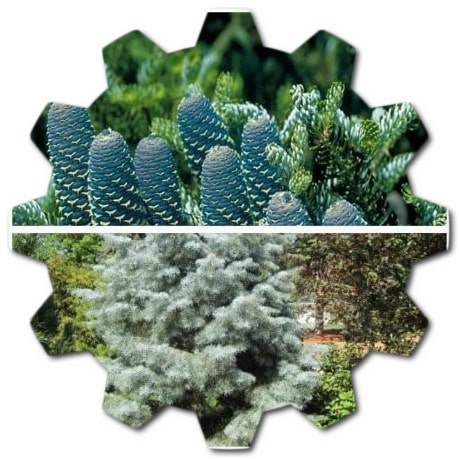The Silvery Fir (Abies Concolor), a member of the Pinacaea family, grows naturally in western North America. It has a diameter of 2.5-3 m. and grows up to 20-25 m. The Silvery Fir has a pyramidal structure. They are tall trees, green in summer and winter, usually pyramidal or narrowly conical in shape. The branches are arranged circumcircularly and directed to the sides. The trunk is rarely forked. The bark is thin and generally smooth on young trees, but on old trees it is thickly furrowed and often grooved at the base.
Buds are round or egg-shaped, rounded or pointed at the tip, resinous or, as in some species, resinless. Shoots are usually glabrous, rarely grooved. Abies concolor, commonly known as white fir, is a species of coniferous tree native to western North America. It is a large and attractive evergreen tree known for its various uses and qualities. Here is an overview of Abies concolor and its uses:
Characteristics of Abies concolor:
- Size: White fir is a large tree that can reach heights of 130 feet (40 meters) or more.
- Needles: The needles are typically blue-green to silvery-blue in color, flat, and about 1 to 2 inches (2.5 to 5 centimeters) long.
- Cones: The cones are cylindrical and stand upright on the branches. They are typically 3 to 6 inches (7.5 to 15 centimeters) long.
- Bark: The bark is smooth and gray when young, becoming furrowed and reddish-brown with age.
Uses of Abies concolor:
- Timber: White fir wood is valued for its straight grain, fine texture, and light color. It is used in construction for framing, millwork, paneling, and as a source of lumber for various applications. The wood is easy to work with, making it suitable for woodworking and carpentry.
- Christmas Trees: White fir is a popular choice as a Christmas tree due to its attractive appearance, soft needles, and pleasant fragrance. It is cultivated for this purpose and is a common species in the Christmas tree industry.
- Landscaping: White fir is used in ornamental landscaping for its symmetrical and pyramid-like shape. It is often planted in parks, gardens, and large residential properties as a shade tree. Its adaptability to various growing conditions makes it a valuable addition to landscapes.
- Wildlife Habitat: White fir provides habitat and food for various wildlife species. Birds, mammals, and insects utilize white fir stands for shelter, nesting, and foraging.
- Essential Oils: The fragrant oils in the needles and wood of white fir are used for making essential oils. These oils are used in perfumes, candles, potpourri, and aromatherapy products.
- Traditional and Medicinal Uses: Indigenous peoples of North America have used parts of white fir for traditional and medicinal purposes. The needles and bark have been employed for their therapeutic properties, such as in teas and poultices.
- Pulp and Paper Industry: In some cases, white fir is used in the pulp and paper industry to produce paper products.
- Erosion Control: White fir is used in reforestation and ecological restoration projects to stabilize soil, prevent erosion, and restore native vegetation in disturbed areas.

Abies concolor is a versatile tree that offers a combination of economic, aesthetic, and ecological benefits. Its adaptability to different environments and its multiple uses make it a valuable species in both natural ecosystems and human landscapes.
How many years does Abies concolor live?
Abies concolor, commonly known as white fir, typically has a lifespan that can vary depending on environmental conditions, competition, and other factors. In general, white fir is a long-lived tree, and it can live for several centuries under favorable conditions.
Mature white firs can commonly live for 200 years or more, and in some cases, exceptionally old individuals have been known to exceed 300 years. However, as with many tree species, the actual lifespan of individual white firs can be influenced by a range of factors, including:
- Environmental Conditions: Trees growing in optimal conditions with sufficient water, good soil, and protection from pests and diseases tend to have longer lifespans.
- Competition: Crowding and competition with neighboring trees can affect the health and longevity of white firs. Trees that have more space and resources available tend to live longer.
- Climate: Climate conditions, including temperature, precipitation, and seasonal variations, can influence the health and growth of white fir trees.
- Pests and Diseases: Infestations of pests or diseases, such as bark beetles or fungal pathogens, can weaken and potentially shorten the life of a white fir.
- Human Activities: Human activities, such as deforestation, land development, and logging, can have a significant impact on the lifespan of white firs in specific areas.
Overall, white fir is considered a long-lived species and can persist for many centuries in the right conditions. In natural and well-managed environments, it contributes to the longevity and biodiversity of forest ecosystems.
What is the homeland of the Abies concolor tree?
Abies concolor, commonly known as white fir, is native to western North America. Its homeland, in terms of its native range, includes various regions in the United States and Mexico. Here are the specific areas where Abies concolor is native:
United States: White fir is native to several western U.S. states, including California, Oregon, Washington, Nevada, Idaho, Montana, Wyoming, Utah, Arizona, and New Mexico. It is most commonly found in the mountainous regions of these states, particularly in the Sierra Nevada and the Rocky Mountains.
Mexico: Abies concolor extends into northern Mexico. It can be found in the Mexican states of Sonora, Chihuahua, Durango, and Coahuila.
White fir is well-adapted to mountainous and forested regions with a variety of elevations and climates. Its natural habitat includes a range of forest types, and it is an important component of mixed conifer forests in its native range. Additionally, it is often cultivated for its ornamental and timber value, both within and outside its native region. Abies Concolur Tree >>
